When you think about Guatemala’s Day of the Dead celebrations, there’s nothing quite like the sight of the barriletes de Guatemala — those giant, colorful kites that fill the sky every November 1st. These aren’t just part of a festival; they’re a way of honoring loved ones who have passed and keeping traditions alive in the most beautiful, unforgettable way.
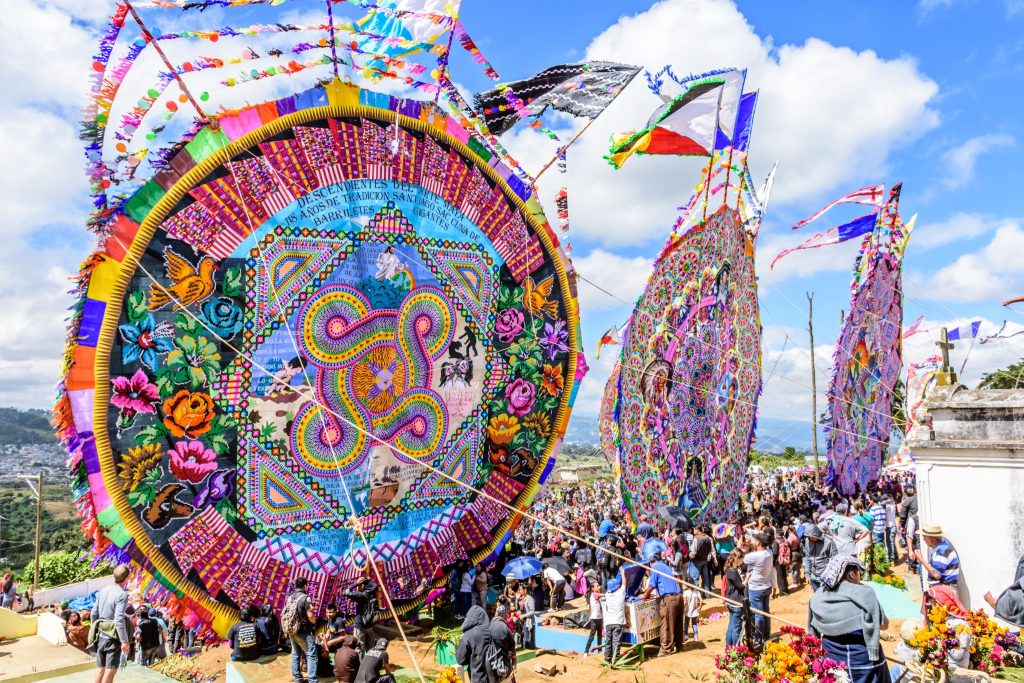
In this article, I’ll share a closer look at what the barriletes are all about — where this tradition started, what the designs mean, how these incredible kites are made, and why they’ve become such an important part of both Guatemalan festivals and Day of the Dead Guatemala traditions. We’ll also talk about how the kite festivals in Sumpango Guatemala and Santiago Sacatepéquez keep this tradition alive today.
Growing up in Guatemala, I always saw pictures of the barriletes in newspapers and watched TV reports showing crowds gathered around these massive, colorful creations. But honestly, it wasn’t until I stood there myself, in a field in Sumpango, watching a kite rise against the backdrop of Volcán de Agua, that I truly felt the connection — to the past, to the people, to something bigger. If you’re curious about this amazing tradition or thinking about seeing it for yourself one day, I’m excited to take you behind the scenes and share what makes the barriletes de Guatemala so special.
What Are the Barriletes de Guatemala?
The barriletes de Guatemala, or Guatemalan giant kites, are much more than colorful creations floating in the sky. They are a living tradition that blends ancient spirituality, community pride, and artistic mastery. Built almost entirely by hand using bamboo, rope, and delicate tissue paper, these enormous kites can stretch up to 20 meters in diameter and are often months in the making.
While many are circular, you’ll also see kites with creative shapes in both Sumpango and Santiago Sacatepéquez — including figures with outstretched wings, human forms, animals, and bold outlines that make the designs pop. Though flat, these shapes give the kites a dramatic presence, and some even include flags or banners attached to the tops to move with the wind.
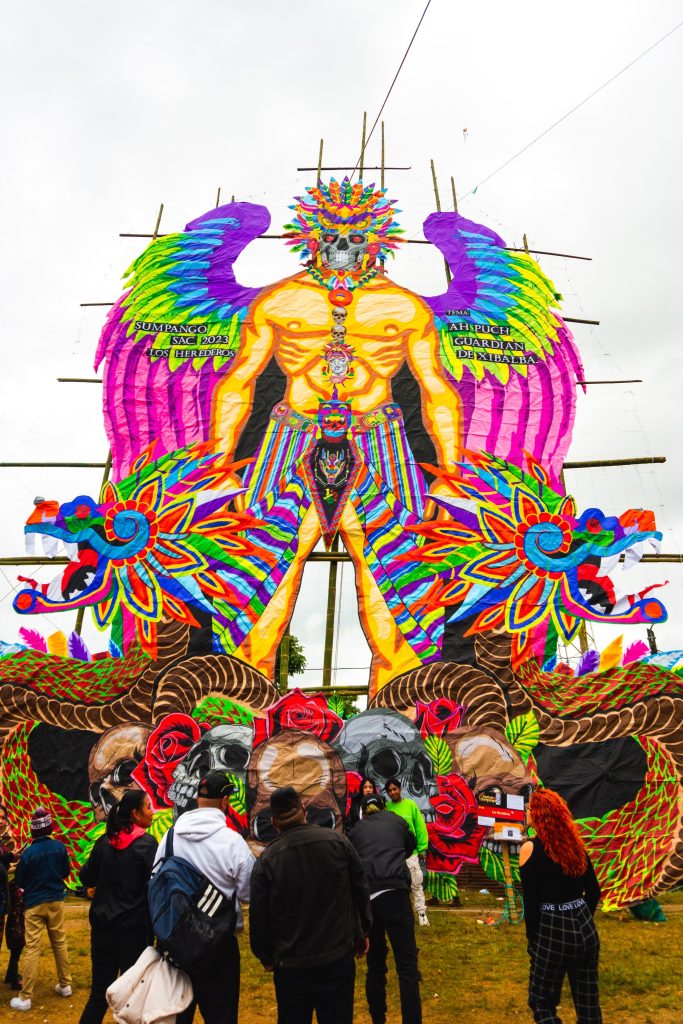
Families and groups spend countless hours designing, cutting, gluing, and assembling the intricate patterns and powerful messages that decorate each barrilete. Some kites are meant to fly, while the largest ones are carefully raised and displayed upright, held in place by wooden structures. Each kite is a reflection of the team that made it — a blend of artistry, faith, and tradition passed down through generations.
What sets the barriletes apart from other kite traditions around the world is their deep spiritual and cultural meaning. Originally created to honor the dead and connect with ancestors during All Saints Day and the Day of the Dead Guatemala celebrations, today’s barriletes also speak to the hopes, struggles, and dreams of modern Guatemala.
The Origins of Guatemala’s Giant Kites
The tradition of building giant kites in Guatemala reaches back hundreds of years, long before the first tourists arrived to admire them. Historians believe the practice has deep roots in Maya Kaqchikel culture, where kites were used in spiritual ceremonies to communicate with the spirit world. It was believed that the colorful kites helped protect villages by clearing away bad spirits and creating a path for the souls of ancestors to visit during special times of the year.
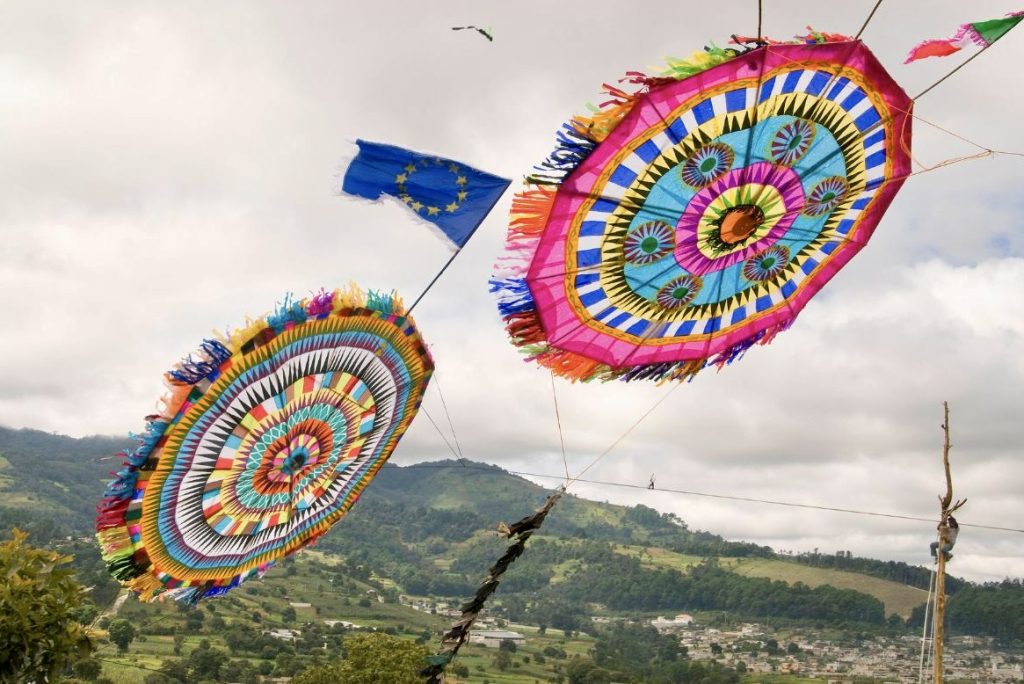
When Spanish colonizers arrived in Guatemala, Catholic traditions like All Saints Day and Day of the Dead were introduced. Over time, the Maya communities wove these new holidays into their own beliefs. The kite tradition evolved too, becoming a way to honor loved ones who had passed while keeping Maya spirituality alive under the surface of Catholic celebrations.
Both Sumpango and Santiago Sacatepéquez have preserved this tradition for generations, each with its own unique approach to the festival — Santiago’s celebration is smaller and more intimate, while Sumpango’s draws larger crowds and more international attention.
Today, when you stand among the giant kites of Sumpango or Santiago Sacatepéquez, you are witnessing not just a festival, but the survival of an ancient way of seeing the world — a celebration where two histories meet and rise together into the sky.
Symbolism and Stories Behind the Designs
Each barrilete gigante is much more than a beautiful piece of art — it’s a story woven from the hopes, struggles, and memories of the people who create it. Traditionally, the designs on the kites focused on honoring ancestors, protecting families from bad spirits, and celebrating the spiritual connection between the living and the dead.
Over time, the meaning behind the designs has grown. Today, many of the giant kites carry powerful messages about issues that affect Guatemala and its Indigenous communities. Some kites show images of nature and remind us to protect the environment. Others call for peace, human rights, or justice for Guatemala’s Indigenous peoples, whose voices have often been silenced. Every color, symbol, and figure carefully glued to the tissue paper tells a part of a larger story.
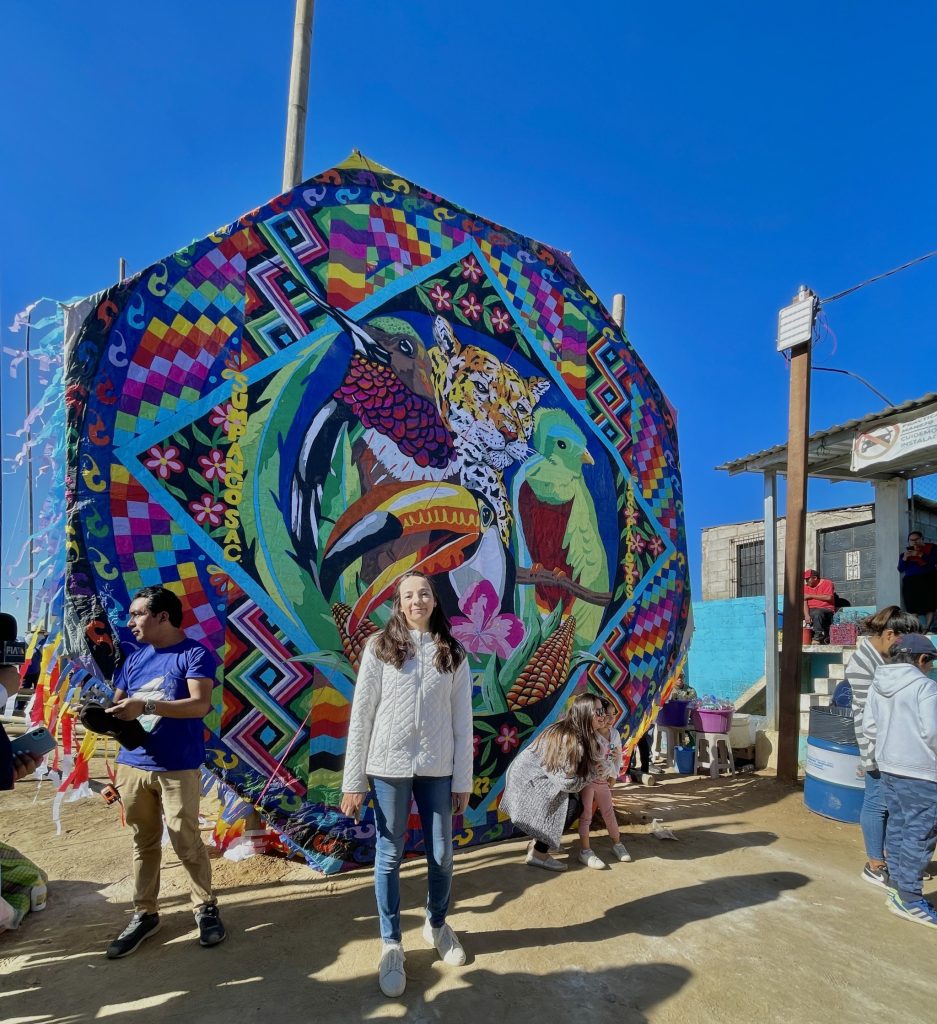
Even the choice of materials reflects deeper meanings. Bamboo represents strength and flexibility. Tissue paper, fragile yet bright, mirrors the delicate but lasting connection between past and present.
When you walk among the barriletes at the festival, it’s not just the size or color that takes your breath away — it’s the feeling that each kite is speaking directly to you, sharing both ancient traditions and the urgent hopes of today’s Guatemala.
How Guatemalan Giant Kites Are Built
Building a barrilete gigante is a true act of patience, teamwork, and artistry. The process starts months before the festival, often during the rainy season, when families and community groups begin meeting to plan their designs. These are not quick projects. Some kites can take up to six months to complete, with hundreds of hours of careful, detailed work.
The frames of the kites are made from long strips of bamboo, tied together with rope or twine to create the strong but flexible base. Bamboo is lightweight enough to lift but sturdy enough to hold the weight of the huge paper designs. The skin of the kite — its colorful surface — is made from thousands of pieces of thin tissue paper, each one cut and glued by hand. Layer by layer, teams build up complex images that look almost like paintings when finished.
Even the glue is made by hand using natural materials like yucca root or cornstarch, helping the delicate paper stay in place without tearing.
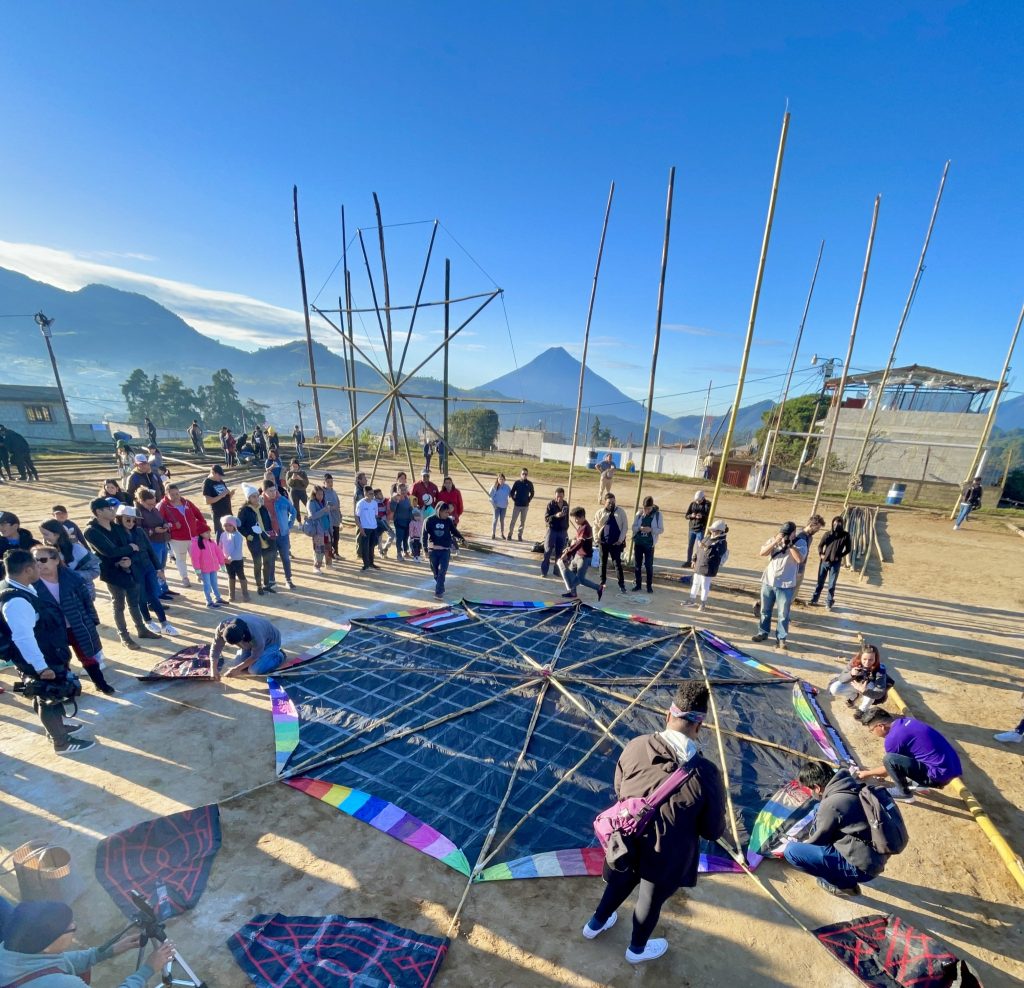
On the morning of the festival, these giant kites are assembled directly on the field. Watching the teams work is one of the most emotional parts of the day — seeing how neighbors, friends, and family members come together to lift something that is both beautiful and meaningful.
In Santiago, some teams even build figures with sculptural effects or three-dimensional elements that rise from the kite’s surface. The level of detail and storytelling varies between communities, but the craftsmanship in both towns is extraordinary. Whether meant to fly or simply to stand, each Guatemalan kite reflects the pride, memory, and resilience of the people who created it.
The Evolution of Barriletes de Guatemala: From Spiritual Bridges to Voices for Change
The first barriletes de Guatemala were simple. Made with natural materials and colored by hand, they served as bridges between the living and the dead, carrying prayers, gratitude, and hopes into the sky during All Saints Day and the Day of the Dead Guatemala celebrations.
But as Guatemala’s history unfolded — with struggles for Indigenous rights, political violence, and migration — the meaning behind the kites began to shift. Today, many barriletes still honor ancestors, but others tell new stories. Some denounce injustice, protest environmental destruction, or call attention to the rights of Mayan communities. Others offer messages of peace, love, and the hope for a better future.

Kite-making has become a way for communities to express not only their faith but also their voices, their dreams, and their frustrations. What once was mainly a spiritual practice has grown into a living, breathing art form — one that continues to evolve with each new generation.
Whether you are drawn to the traditional designs or the bold, modern messages, standing among the barriletes is a powerful reminder that in Guatemala, memory and hope are carried on the same wind.
Kites, Day of the Dead, and Guatemalan Traditions
In Guatemala, the Giant Kite Festival is more than a celebration of art — it’s a way of connecting with those who are no longer here. The festival takes place on November 1st, which is All Saints Day, and is closely tied to Day of the Dead traditions in Latin America. While many Latin American countries celebrate by building altars or decorating graves, Guatemala adds something unique to the sky: the barriletes gigantes.
The tradition began as a way to communicate with spirits and guide them safely back to visit their families. Even today, many believe the giant kites help clear the skies of bad energy, creating a path for souls to return. During the festival, families also gather to share special foods, including fiambre, a colorful cold salad made with vegetables, meats, and pickled ingredients. It’s a dish that brings families together and honors loved ones who have passed.
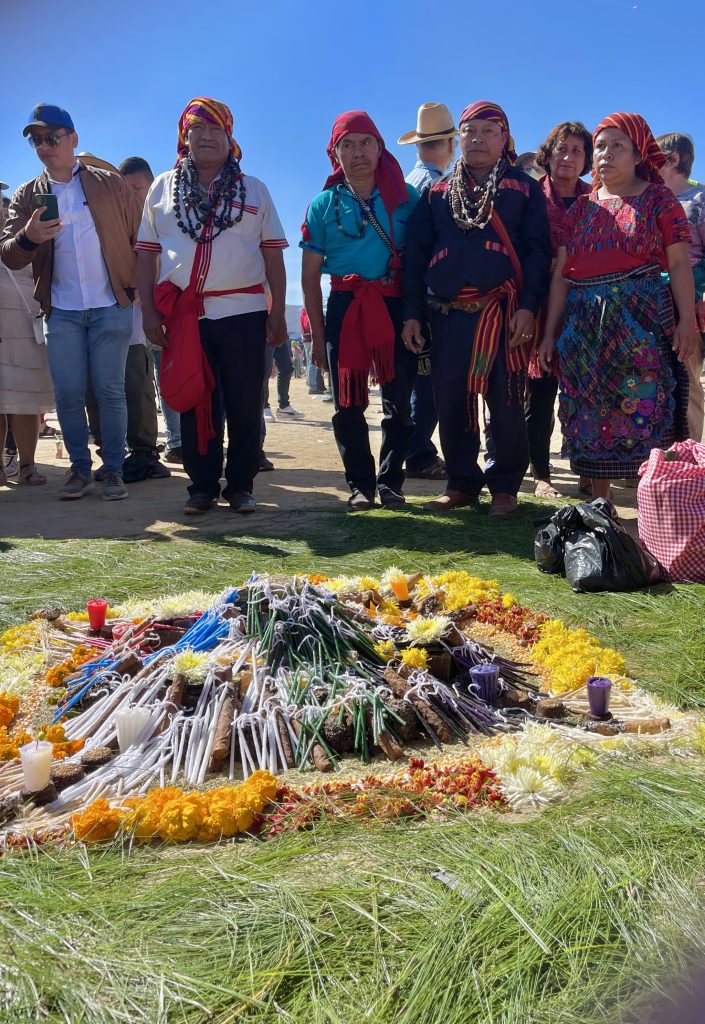
The spiritual meaning of the festival is present not just in the kites themselves, but in the ceremonies that open the day. Maya spiritual leaders often hold a blessing before the kites are raised. A circle forms around a ceremonial altar made from pine needles, marigolds, candles, and bundles of tied sticks arranged in symbolic shapes. The colors and patterns reflect the four cardinal directions, the natural world, and the connection between the living and the dead. With the scent of incense in the air, prayers are offered to the ancestors and to the earth. It’s a moment of stillness before the celebration begins — and a reminder that this is sacred ground, not just a festival field.
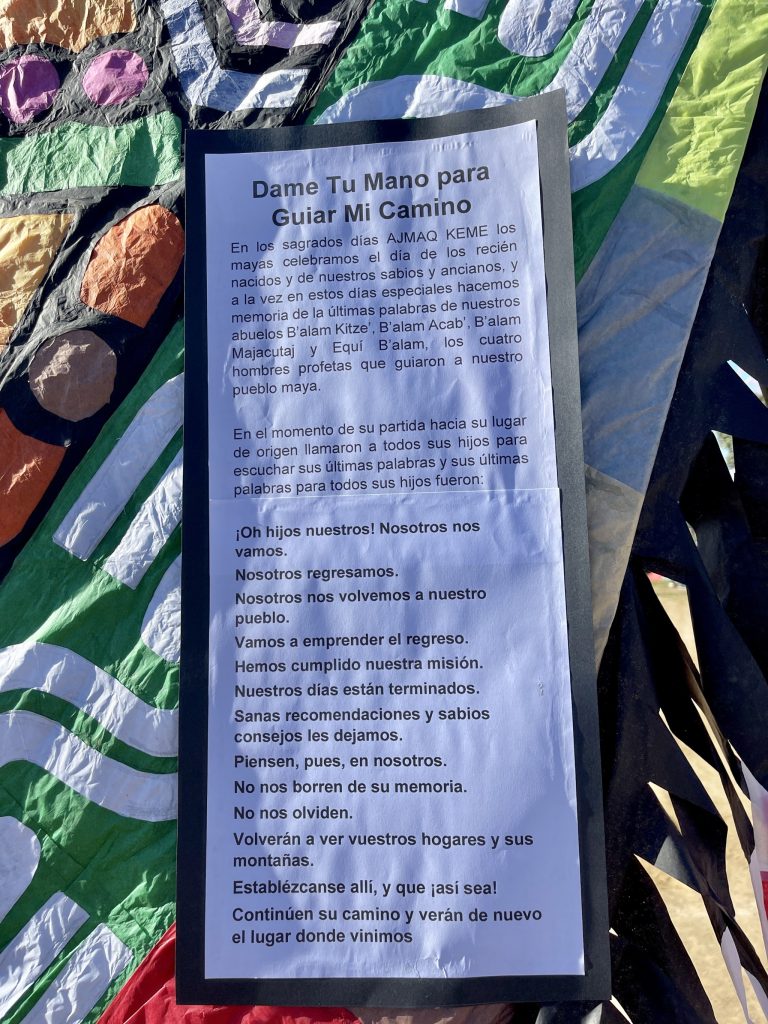
Some kites even include prayers or messages for the ancestors. One I saw last year carried a note that read:
“¡Oh hijos nuestros! Nosotros nos vamos… No nos olviden. Volverán a ver vuestros hogares y sus montañas… Establézcanse allí, y que ¡así sea!”
This message — written in honor of Maya elders and prophet leaders — called on descendants not to forget where they come from, and to continue walking forward with memory and purpose.
In Santiago Sacatepéquez the giant kites stand stall surrounding the small cemetery where While in Sumpango of this takes place under the shadow of Volcán de Agua, which rises behind the field like a silent witness. The volcano, the kites, the wind, the colors — they all come together in one breathtaking moment that blends tradition, nature, and spirit in a way only Guatemala can.
Where to See the Barriletes Gigantes in Guatemala
If you want to experience the barriletes gigantes in person, there are only two towns in Guatemala where you can see them in their full size and splendor: Sumpango and Santiago Sacatepéquez, both located in the department of Sacatepéquez, near Antigua. These are the only places where the tradition of building giant kites for All Saints Day has continued at this scale.
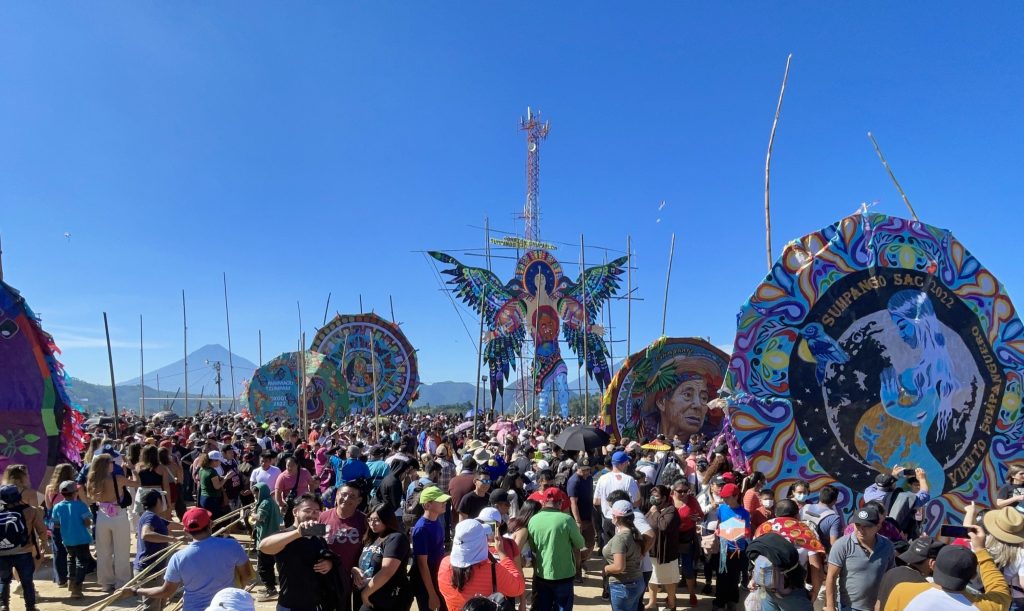
Sumpango’s festival is larger and draws big crowds, including many international visitors. Santiago’s celebration takes place next to the cemetery where tombs and mausoleums are decorated with flowers, and it is more intimate and rooted in local tradition, but equally impressive in its artistry. Both towns display dozens of enormous kites — many over 10 meters wide and some reaching up to 20 meters high — each one a work of communal devotion, cultural memory, and visual storytelling.

In recent years, a selection of kites from the festivals — often the largest and most symbolic — have also been displayed in Parque Central in Antigua Guatemala after November 1st, offering a second chance to see them up close. These post-festival displays give visitors more time and space to appreciate the detail and meaning without the crowds.
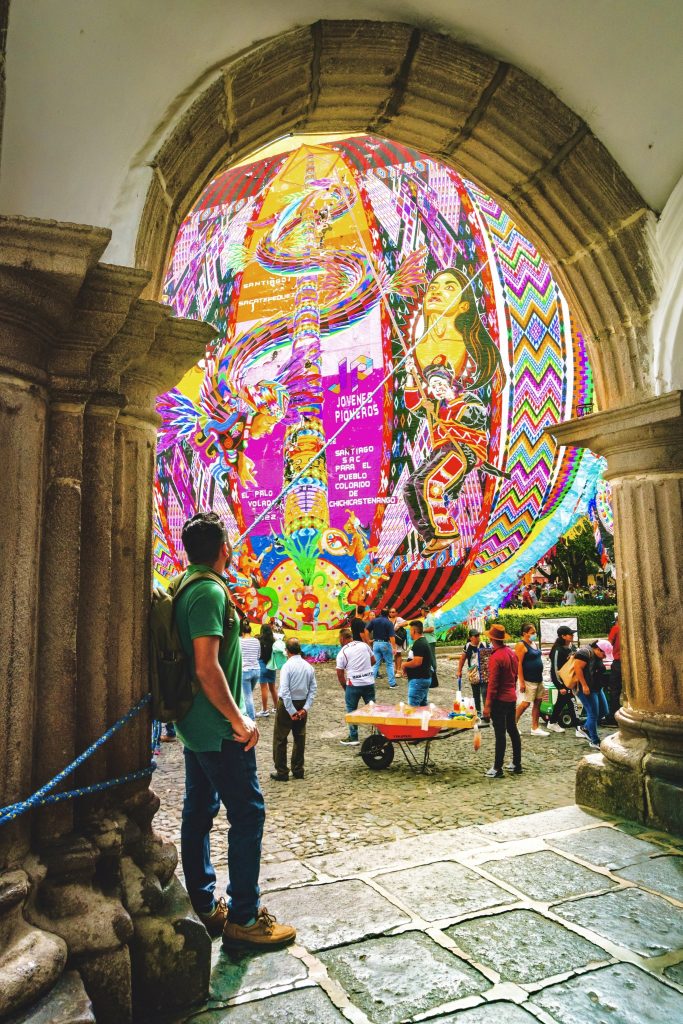
To learn more about the Sumpango kite festival, check my complete guide:
Giant Kite Festival Guatemala: Insider Tips for Experiencing Sumpango’s Barriletes Gigantes
- Cranberry Brie Cake Grazing Board (An Elegant Holiday Cheese Centerpiece) - December 19, 2025
- Easy Cranberry Cocktails You Can Make All Year - December 18, 2025
- Christmas Mulled Wine (A Classic Holiday Mulled Wine Recipe) - December 18, 2025


